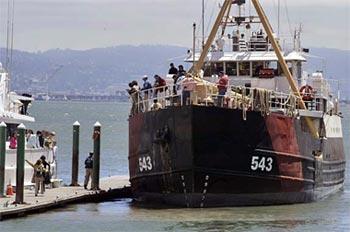Samuel "Doc" Gruber, a marine biologist at the University of Miami, has studied juvenile lemon sharks in the Bahamas for three decades. His research, conducted largely in a Bimini Islands lagoon nursery, has produced one of the world's most comprehensive shark studies.
 It has also spotlighted how little we know about species.
It has also spotlighted how little we know about species.
"We've been looking at [lemon sharks] for maybe 30 years, and as a result we know a tremendous amount about their early life—but nothing whatsoever about the adult stages," the scientist said. "That's why I'm so excited about [my current] work."
Gruber's current work involves the dramatic aggregations of several hundred adult lemon sharks off the coast of Jupiter, Florida, each year. The mass gatherings, which offer scientists a unique opportunity to meet adults face-to-face, are believed to be part of the animal's reproductive cycle.
Surprisingly, scientists have never observed lemon sharks mating.
Pre-Mating Ritual?
Like salmon and certain other marine species, lemon sharks (Negaprion brevirostris) return to their natal grounds to give birth.
"If you were mating with your sister or your mother, you might have some inbreeding problems," Gruber said. "If a whole population was less than 100 or 200 animals, you might expect to see sharks with twelve fins." Yet lemon sharks appear nomal. "This perplexed us."
To avoid inbreeding problems within their relatively small populations, the sharks appear to have developed a mating strategy as yet unobserved in other shark species: Though female lemon sharks return to their natal grounds each year, males remain nomadic.
The strategy ensures genetic diversity among different lemon shark populations. It may also have spawned the phenomenon of large lemon shark gatherings, like the ones found near Jupiter, Florida. Such gatherings guarantee that the two sexes get together.
"We believe that a bunch of females go to a certain place where there's a current and put out pheromones to attract males," Gruber said. "When they have attracted a great enough number—a critical mass—they begin to mate."
"I suspect that quite a few [shark] species could do this," he added. "But nobody knows."
Human-Shark Encounters
Reports from local divers near Jupiter Inlet gave Gruber and his team a chance to find and dive on the enormous shark gatherings earlier this year.
"We have lots of ideas and experiments, but the only way we can do them is to actually get hold of the animals," the marine biologist said. "Our goal was to see if we could catch and sample lemon sharks in this aggregation."
Specialized, quiet diving equipment allowed researchers to observe the sharks at close range. But the team had only limited success in capturing the animals with conventional hook-and-line fishing.
Enter dive expert Randy Jordan, owner of a Jupiter dive shop. Jordan tried an unnerving technique—hand-feeding baited hooks to selected sharks.
"It was a little bit exciting, but it worked," Jordan said. "When I went down with the baited hook, my main concern was not to get entangled in the hook or line and become part of the catch. I could just picture a full-grown lemon dragging me around the reef."
"The plan seemed simple, until I fed the first one," Jordan continued. "I approached a large female and dropped the baited hook directly in front of her mouth."
"She grabbed it like the free lunch it was. When she took off, I released the line and stood back. Six other sharks charged me to get their share," he added. "I punched one with the end of my gun and headed up a few feet to gain a vantage point."
"After a couple of minutes of negotiation, they realized I was empty and left."
Despite a few harrowing moments, the technique proved that the team could reliably catch, sample, and tag adult lemon sharks in the swarm. It even enabled scientists to target specific sizes of male and female sharks.
"The shark's well-being takes a very close second place behind personal safety on these projects," said Grant Johnson, a manager of Gruber's Bimini Biological Field Station and part of the Jupiter research team. "Just as much is done to release the animals unharmed as is done to make sure the people working are unharmed."
The tagging effort was only a test run for more extensive sampling that the researchers plan for early next year. Gruber hopes to use satellite tracking to chart the movement of both lemon sharks and their seasonal swarm.
"Once the aggregation breaks up, where do males and females go?" Gruber said. "Do males come from all over and females have a specific pattern? At this point nobody has any idea where they go."
Gruber's satellite tags can function for some six months and take a data reading every hour. Measurements of depth, water temperature, and light levels would allow the scientists to accurately map individual sharks' migration patterns.
"The adult stage of the lemon shark is one of the few remaining mysteries of this species," Johnson said. "If we can find out where these sharks came from, what they are doing, and where they go afterwards, we can essentially map out the entire life history of this animal, from birth to the large adult. That is something that has never been done."
Source: news.nationalgeographic.com
Read the full article:
Lemon sharks swarm Florida "Lovers Lane"
 Coral Queen, the popular Red Sea diving liveaboard sunk in early July, has been refloated and has returned to port for repairs.
Coral Queen, the popular Red Sea diving liveaboard sunk in early July, has been refloated and has returned to port for repairs.







.jpg)













